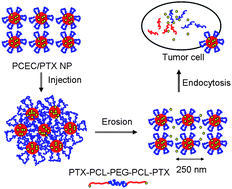Thermosensitive in situ hydrogel of paclitaxel conjugated poly(ε-caprolactone)-poly(ethylene glycol)-poly(ε-caprolactone)†
Abstract
This paper aimed at engineering a multifunctional

* Corresponding authors
a
School of Chemical Engineering and Technology, Tianjin University, Tianjin, PR China
E-mail:
ajdong@tju.edu.cn
Fax: +86 22 27890710
Tel: +86 22 27890706
This paper aimed at engineering a multifunctional

 Please wait while we load your content...
Something went wrong. Try again?
Please wait while we load your content...
Something went wrong. Try again?
X. Lin, L. Deng, Y. Xu and A. Dong, Soft Matter, 2012, 8, 3470 DOI: 10.1039/C2SM07172J
To request permission to reproduce material from this article, please go to the Copyright Clearance Center request page.
If you are an author contributing to an RSC publication, you do not need to request permission provided correct acknowledgement is given.
If you are the author of this article, you do not need to request permission to reproduce figures and diagrams provided correct acknowledgement is given. If you want to reproduce the whole article in a third-party publication (excluding your thesis/dissertation for which permission is not required) please go to the Copyright Clearance Center request page.
Read more about how to correctly acknowledge RSC content.
 Fetching data from CrossRef.
Fetching data from CrossRef.
This may take some time to load.
Loading related content
